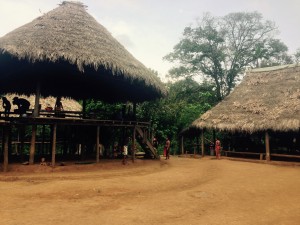Standing at the bow of a long dugout canoe, our guide skillfully guides us through the stony fords of the San Juan River. He moves with confidence and seems familiar with the river’s curves and currents, using a long wooden pole to keep us from touching the bank. As we move upstream, kingfishers dive from steep rock embankments and glide over the water, disappearing into the forest on the other side. Long vines and leafy tendrils hang from the towering canopy sway over the bank. We approach a cluster of palm huts that overlook the river, and the sounds of flutes and drums dance across the water to greet us. We have arrived at the Embera village.
Prior to making this incredible journey, I had no idea what to expect from our Embera village visit. In the past, I’ve had the opportunity to see the tropics and even interact with local people living in rural communities. But I knew that this experience would be different. The Embera are a group of indigenous people who live along the rivers of Panama and Columbia. More than 30,000 Embera live in Panama, and while some have chosen to live in towns and urban areas, many still cling to the cultures and traditions of their ancestors. The riverbanks that they call home provide them with so many of their necessities- food, transport, and even aspects of their spiritual life. They are skilled artisans with a rich culture that refuses to be erased by increasing urbanization and mounting economic pressure. In addition to giving our group a delicious traditional meal and intrinsic tribal body tattoos (temporary, of course), they also imparted us with something that will surely last a b it longer- a new perspective.
it longer- a new perspective.
Nature is at the center of the Embera lifestyle. Today the village shaman led our group through winding forest trails, explaining the importance of multiple native plants. Medicinal herbs are used to heal ailments ranging from impotency to hemophilia. Multi-generational homes are constructed out of sturdy palm beams and bark, and vibrantly colored crafts are dyed with the pigments of roots and leaves. Fruits and vegetables, including the best tasting pineapple I’ve ever had, are grown along the fertile riverbanks. And in all of this utilization of the natural resources that surround them, the Embera people maintain a deep-rooted respect for the natural world. So many people (including myself at times) seem to become detached from nature. When our food comes to us from refrigerated Kroger aisles and our clothes are made an ocean away, it becomes so easy to distance ourselves and the commodities we use daily from the natural world. The word ‘nature’ becomes associated with trips to state parks and National Geographic covers. Today my experience with the Embera people gave me a reminder that I desperately needed. As humans, we are not separate from nature; we are a part of nature. And as a part of nature, it is our responsibility to maintain the natural world to the best of our ability, to accept responsibility for the consequences of our actions, and to actively seek solutions to the problems that exist today. Perhaps if more people could take a lesson from the Embera and adopt this mindset, we could move forward in creating a healthier, more sustainable world.
nature. When our food comes to us from refrigerated Kroger aisles and our clothes are made an ocean away, it becomes so easy to distance ourselves and the commodities we use daily from the natural world. The word ‘nature’ becomes associated with trips to state parks and National Geographic covers. Today my experience with the Embera people gave me a reminder that I desperately needed. As humans, we are not separate from nature; we are a part of nature. And as a part of nature, it is our responsibility to maintain the natural world to the best of our ability, to accept responsibility for the consequences of our actions, and to actively seek solutions to the problems that exist today. Perhaps if more people could take a lesson from the Embera and adopt this mindset, we could move forward in creating a healthier, more sustainable world.
